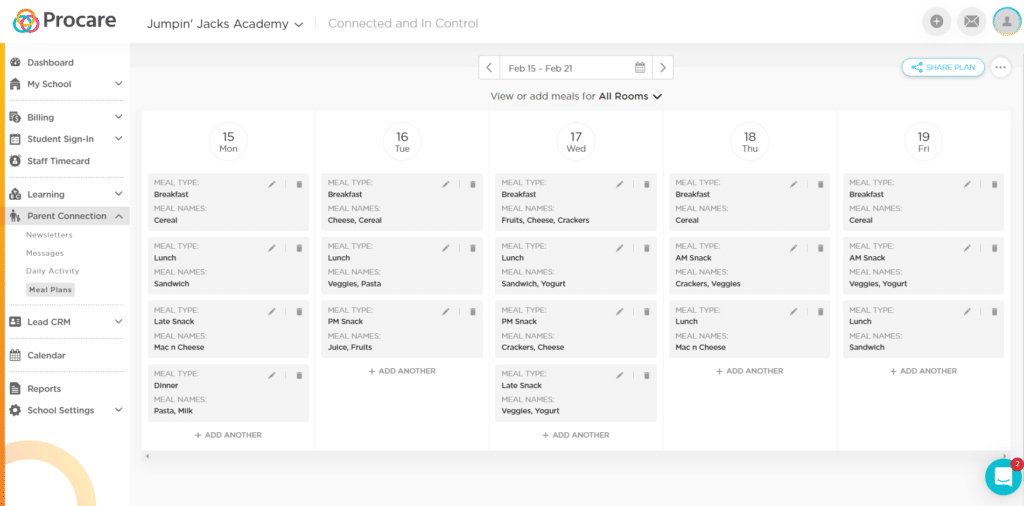
Child care nutrition standards are set by the U.S. federal government to help make sure child care centers in their jurisdiction are providing adequate nutrition to kids in their care. These standards outline daycare nutrition guidelines for serving healthy, balanced meals.
Along with nutritional best practices, these government standards are a great starting point for planning meals for kids in your center. In this post, we’ll talk about the importance of nutrition standards for children, daycare food regulations in the United States, and principles you can use to go above and beyond the regulations to guide kids toward a healthy lifestyle.
Why are Child Care Nutrition Standards Important?
It’s pretty likely that if we put kids in charge of dietary requirements, the guidelines would be reminiscent of something out of Willy Wonka. If left to their own devices, kids’ diets would probably be centered on sugar, sugar and more sugar. Although we can all agree that sugary treats are delicious, we know too much can lead to a variety of issues, including childhood obesity. That’s why it’s important for caregivers to help kids develop healthy eating habits that will serve them for life.
Eating healthy helps kids feel good about their bodies and maintain the energy they need to play, learn and grow every day. Adequate nutrition, including a diet low in sugar, is crucial for development of bones, teeth and muscles, and prevents health problems later in life. Research also shows that imbalanced diets contribute to emotional and learning challenges.
Mealtimes at your center are an important opportunity for children to learn to enjoy a variety of foods, develop motor skills, learn more about food and where it comes from, and socialize with adults and other children. Discovering the pleasure of healthy eating and observing good food practices in adult role models sets kids up to develop positive lifelong habits and attitudes around food.
Experienced child care providers know and science confirms that healthy diets lead to healthy, happy kids who learn, play and socialize at their best. Read on to find out how to make sure the meals and snacks at your center meet nutritional guidelines and best practices.
How Does Child Care Nutrition Impact Learning?

Child Care Nutrition Standards in the United States
In the United States, nutrition standards for child care and adult day care centers are set by the USDA. The USDA’s Child and Adult Care Food Program (CACFP) is a federal program offering reimbursement to child care and adult day care centers for serving nutritious meals and snacks.
To be eligible for reimbursement, a meal must meet CACFP nutrition guidelines. Child care centers can claim up to two reimbursable meals and one snack, or two snacks and one meal per each eligible child, every day.
The CACFP guidelines outline meal patterns to help care providers make healthy choices for kids by including various food groups and adjusting serving sizes by age. All meal components are to be served in a specific portion size depending on the child’s age group.
Receiving CACFP funds? You may be eligible for emergency funding made available to support centers as they navigate the pandemic. Learn more.
Breakfast, lunch and supper, and snacks each follow different meal patterns:
- Breakfast should include portions of fluid milk, grains, and fruits or vegetables.
- Lunch and supper should include portions of fluid milk, meat or meat alternatives, grains, fruits and vegetables.
- A snack should include portions of at least two of the following: fluid milk, meat or meat alternatives, grains, fruits and vegetables.
The program also outlines requirements for following the meal patterns in a healthy way by reducing sugar consumption and emphasizing a varied diet. For instance, there are limitations on the use of juice for a fruit serving, and cereals and yogurts must be low in sugar. At lunch and dinner, a vegetable may be used to fulfill the fruit requirement, but two different vegetables must be served rather than a double helping of one vegetable.
7 Best Practices for Child Care Nutrition

What are some best practices for child care nutrition?
In addition to its meal pattern guidelines, the USDA provides a list of best practices that child care providers should follow to ensure kids are getting the most benefit from the meals they enjoy while in daycare.
Our list of seven best practices combines recommendations from the USDA with our own insights on how to enhance nutritional practices in child care.
Serve a Variety of Foods
Serving a variety of foods helps to ensure that kids get all the essential nutrients they need to grow up healthy and strong. It can also play a role in supporting gut health, heart health and strengthening the immune system.
The USDA recommends that child care centers:
- Serve a fruit or vegetable as one of the two required components of each snack,
- Choose whole fruits and vegetables more often than juice, and
- Provide at least one serving per week of:
- Dark green vegetables (broccoli, spinach, kale, etc.)
- Red and orange vegetables (red peppers, carrots, sweet potatoes, etc.)
- Beans and peas (green or yellow string beans, green peas, etc.)
- Starchy vegetables (corn, potatoes, parsnips, etc.)
- Other vegetables (celery, asparagus, cauliflower, etc.).
Model Positive Eating Habits
Children learn their attitudes to food from the adults around them. A family-style dining environment where staff choose from the same healthy meal options as children, and engage with kids while avoiding screens, helps to reinforce healthy choices and eating behaviors in kids.
Teach Kids about Hunger Cues
Kids are in the process of learning their food preferences and hunger signals, and this should be respected and encouraged.
Encouraging kids to continue eating when they are full, coercing kids into eating foods that they don’t like or want, or using food as a reward can foster a unhealthy attitude toward eating. Instead, let child care providers should let kids decide how much and what to eat.
Avoiding Serving Foods with Excess Sugar
According to the CACFP, child care providers should avoid serving foods that contain added sugar. This includes sweet toppings like honey, jam, syrup and candy – but the main ones to watch out for are sugary beverages.
Sugar-sweetened beverages include:
- Fruit juices
- Sodas
- Iced tea or sweetened tea
- Sports drinks
- Energy drinks
- Flavored milks (chocolate, strawberry, etc.)
Sugar-sweetened beverages are a non-nutritive source of excess sugars that have been linked with a number of adverse health outcomes in adults, including diabetes, heart disease and obesity. Focus on serving kids water or white milk instead of sugar-sweetened beverages.
Remember Food Safety
Children under five are more likely to get sick and have a more serious illness from food poisoning. To protect kids, child care providers need to follow the appropriate food safety measures at all times. These include:
- Washing hands, kitchen utensils and kitchen surfaces before preparing meals
- Keeping raw meat, chicken, seafood and eggs separate from other foods during preparation
- Cooking foods to the appropriate internal temperature to kill germs
- Refrigerating perishables and leftovers within one hour to prevent bacterial growth
Train and Educate Staff about Nutrition
A healthy diet begins with educated child care staff who understand how to choose and prepare healthy meals, read nutrition labels and follow the latest science on nutrition. Ongoing professional development will help the staff at your center provide first-class nutrition to kids.
Support Breastfeeding
Many mothers breastfeed their infants, which has been shown to be an important source of nutrition for children under 12 months of age. The American Academy of Pediatrics recommends exclusive breastfeeding for the first six months of life, then another six months of breastfeeding while introducing complementary foods.
Child care centers should work to create a safe, quiet and private area for mothers who visit the center to breastfeed. They can also encourage moms to supply breast milk that can be stored for later use.
Child care providers should keep in mind that not all mothers can or choose to breastfeed – or perhaps they do a hybrid formula-breastmilk approach. It’s important to support mothers and caregivers in whatever way they feed their infant.
Track Meals & Create Daily Menus with Procare Solutions

Providing a balanced and nutritious diet is just one of the things you do to make sure your center is the best place for kids to grow and thrive. Our mission is to ease the other burdens you face — including complex requirements like CACFP reimbursement.
With Procare’s child care management app, you can save hours of work recording and tracking your CACFP meal counts. Features like printable meal roll-call sheets, meal counts and tallies for both meals served and claimed, age grouping and parent-friendly menus, Procare makes it easier than ever to effectively manage CACFP meal claims while limiting food waste and keeping parents informed on nutritional practices.
Procare’s powerful suite of features, including child care billing, activity tracking and contactless drop-off/pick-up, streamlines operations at your center so you have time for careful meal planning and nutritional education.
Interested in learning more about what Procare can do for your center?
Request a Demo
Request a demo and talk with one of our friendly Procare experts to get a tailored child care solution for the unique needs of your business.



